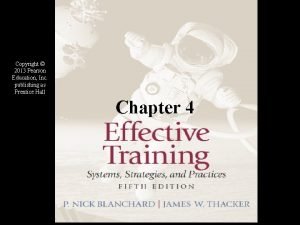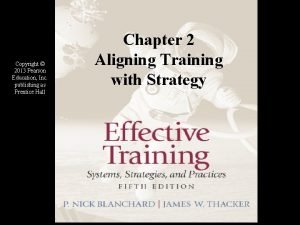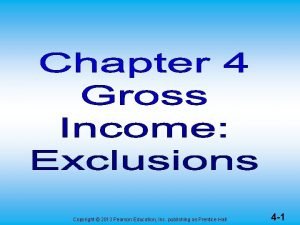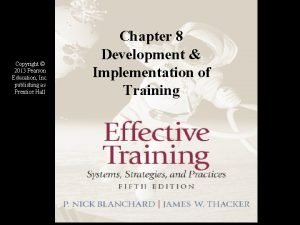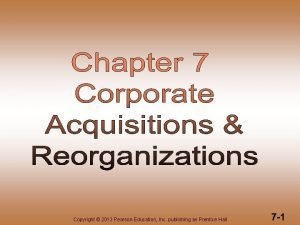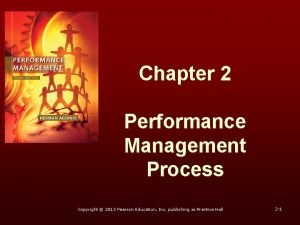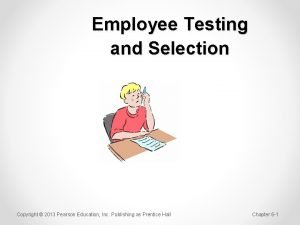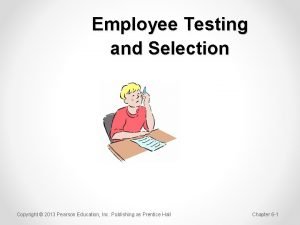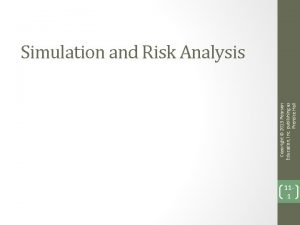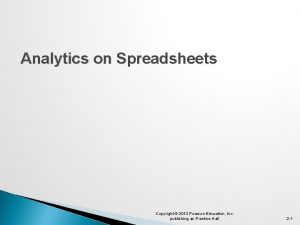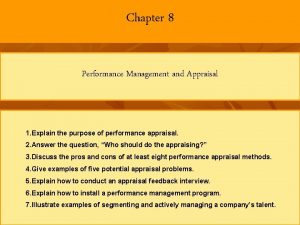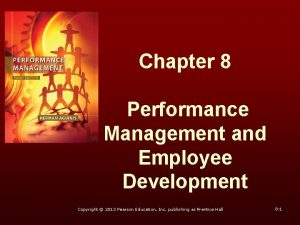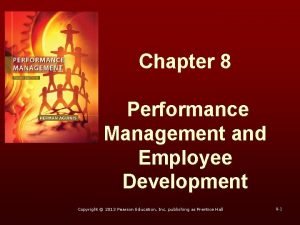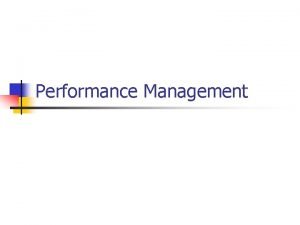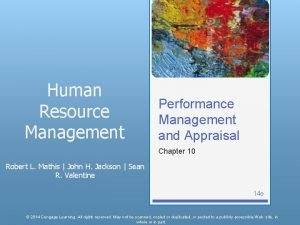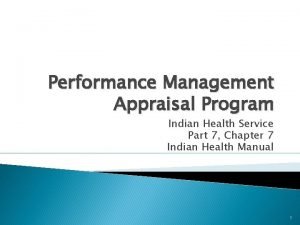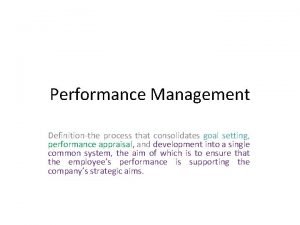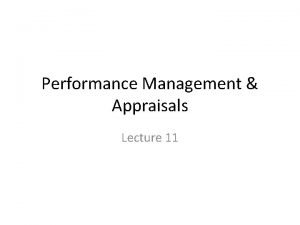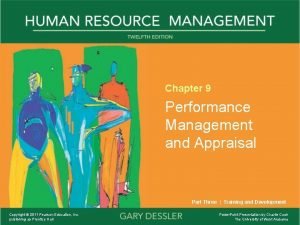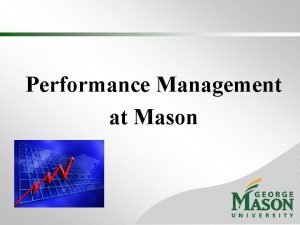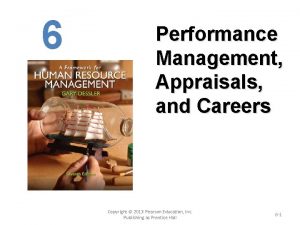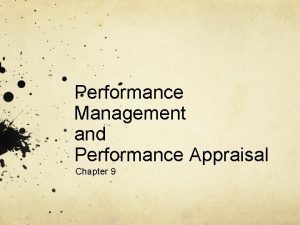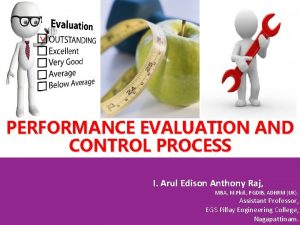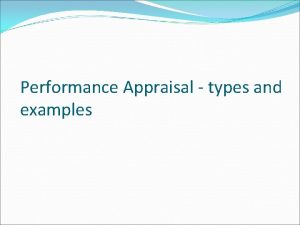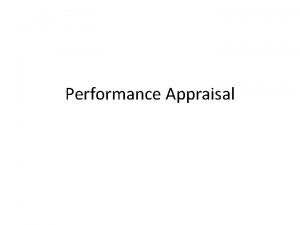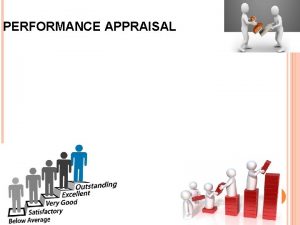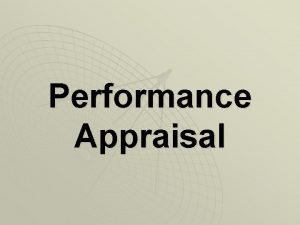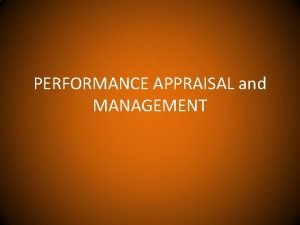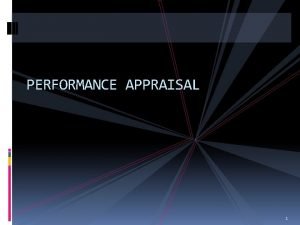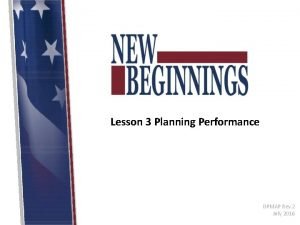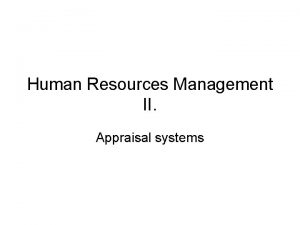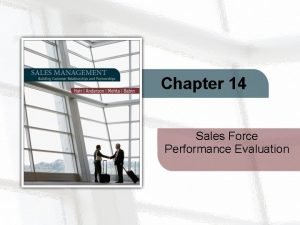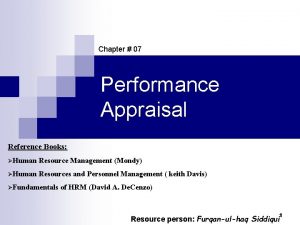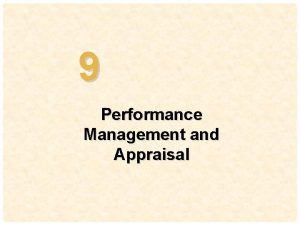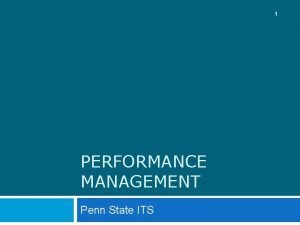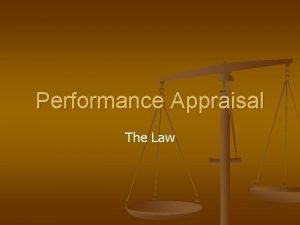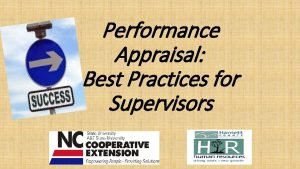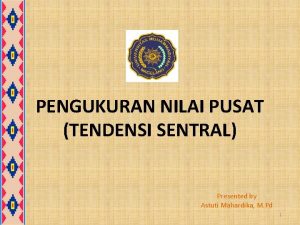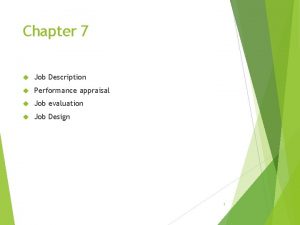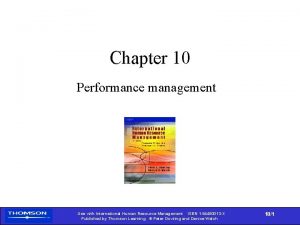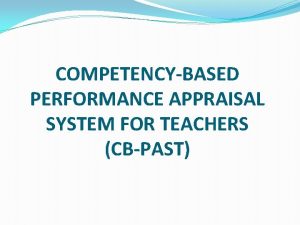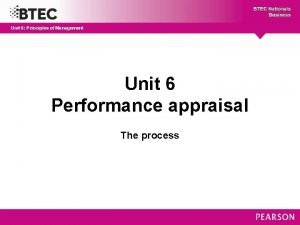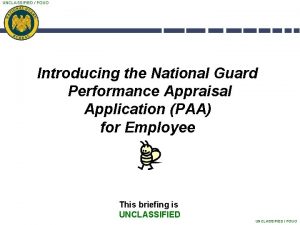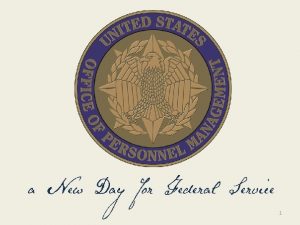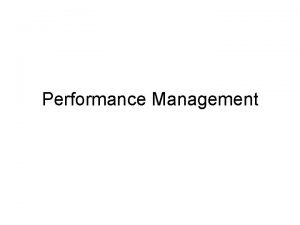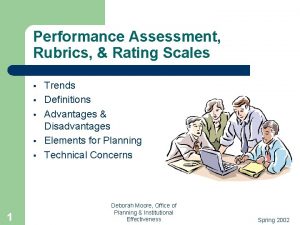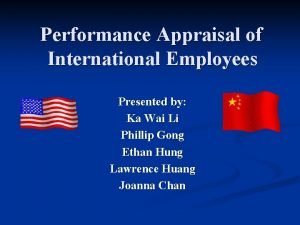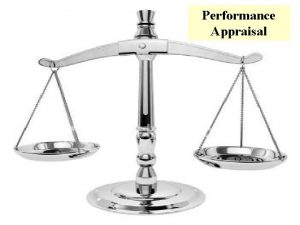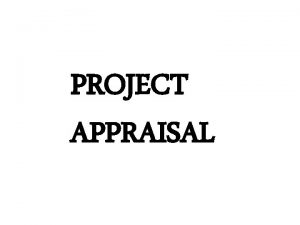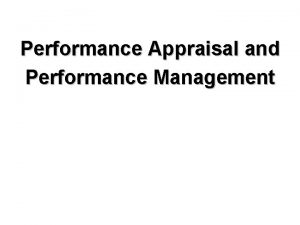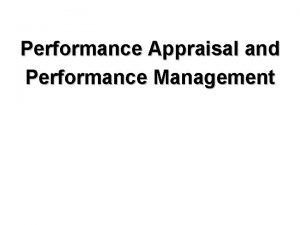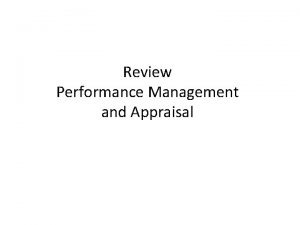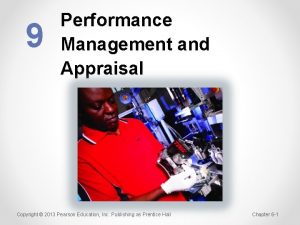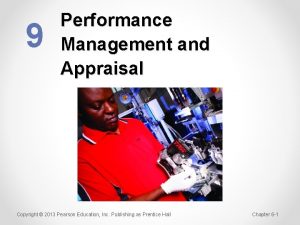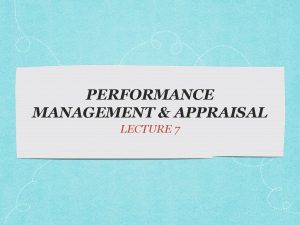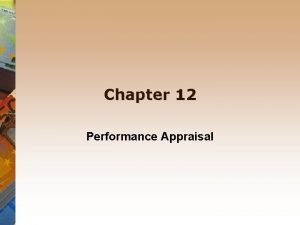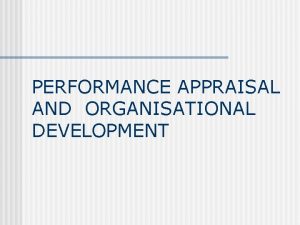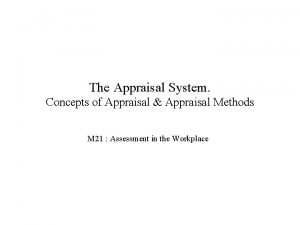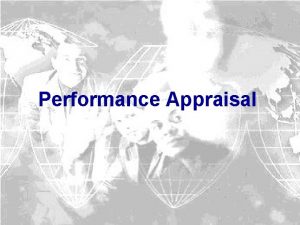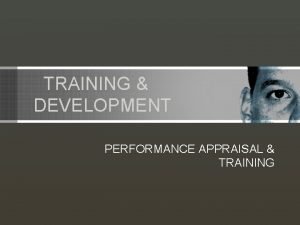Performance Management and Appraisal Copyright 2013 Pearson Education







































































































- Slides: 103

Performance Management and Appraisal Copyright © 2013 Pearson Education, Inc. Publishing as Prentice Hall Chapter 6 -1

Performance Appraisal In this lecture we will get an overview of the performance appraisal process and the different tools and methods available. The main topics covered include the performance management process, appraisal methods, appraisal performance problems and solutions, and the appraisal interview. Despite lots of attention, money, and effort, performance appraisals remain an area with which few managers or employees are satisfied. Copyright © 2013 Pearson Education, Inc. Publishing as Prentice Hall Chapter 9 -2

Learning Objectives 1. Define performance management and discuss how it differs from performance appraisal. 2. Describe the appraisal process. 3. Set effective performance appraisal standards. Copyright © 2013 Pearson Education, Inc. Publishing as Prentice Hall Chapter 9 -3

Learning Objectives 4. Develop, evaluate, and administer at least four performance appraisal tools. 5. Explain and illustrate the problems to avoid in appraising performance. Copyright © 2013 Pearson Education, Inc. Publishing as Prentice Hall Chapter 9 -4

Learning Objectives 6. Discuss the pros and cons of using different raters to appraise a person’s performance. 7. Perform an effective appraisal interview. Copyright © 2013 Pearson Education, Inc. Publishing as Prentice Hall Chapter 9 -5

Lets recap on Fridays themes • “Is it best to train people on the job or off the job? ” Copyright © 2013 Pearson Education, Inc. Publishing as Prentice Hall Chapter 8 -6

Discussion • Managerial On-The-Job Training methods include job rotation, coaching/ understudy approach, and action learning. • 1. Job rotation involves moving management trainees from department to broaden their understanding of all parts of the business. • 2. The coaching/understudy approach occurs when a trainee works directly with a senior manager or with the person he/she is to replace, and the latter is responsible for coaching the trainee. • 3. Action learning programs give managers and others released time to work full time on projects to analyze and solve problems in departments other than their own. Copyright © 2013 Pearson Education, Inc. Publishing as Prentice Hall Chapter 8 -7

Off-the-Job Management Training and Development Techniques • 1. The case study method presents a trainee with a written description of an organizational problem. • 2. Management games are computerized management games allow for the trainees to be involved. • 3. • 4. University-related programs provide executive education and continuing education programs in leadership, supervision, and the like. • 5. Role playing is aimed at creating a realistic situation and then having the trainees assume the parts (roles) of specific persons in that situation. • 6. Behavior modeling involves showing the trainee the correct way to do something, letting the trainee practice the correct way, and giving the HR. Outside seminars are offered by many companies and universities. Copyright © 2013 Pearson Education, Inc. Publishing as Prentice Hall Chapter 8 -8

Off the job • 6. Behavior modeling involves showing the trainee the correct way to do something, letting the trainee practice the correct way, and giving the trainee feedback on his/her performance. Behavior modeling is one of the most widelyused interventions, both for teaching supervisory-type skills and particularly for behavioral computer skills training. • 7. Corporate universities are in-house development centers that have been established by many companies to expose prospective managers to realistic exercises that develop improved management skills. • Executive coaches are being used by firms to improve their top managers’ effectiveness. An executive coach is an outside consultant who questions the executive’s boss, peers, subordinates, and sometimes, family, in order to identify strengths and weaknesses. The coach then counsels the executive so he or she can capitalize on those strengths and overcome the weaknesses. • The SHRM Learning System encourages HR professionals to get certified by taking one of three exams: professional, senior professional and global HR. Copyright © 2013 Pearson Education, Inc. Publishing as Prentice Hall Chapter 8 -9

OK Lets start Today's lecture! Lets define performance management and discuss how it differs from performance appraisal. Copyright © 2013 Pearson Education, Inc. Publishing as Prentice Hall Chapter 9 -10

Performance Management Performance management has to do with creating an organizational system that is fair, effective, and widely understood by all. The goal of the system is to support the strategic aims of the firm by establishing a valid and reliable process connecting the employees to it. Copyright © 2013 Pearson Education, Inc. Publishing as Prentice Hall Chapter 9 -11

Performance Appraisal Performance appraisal involves : (1)setting work standards, (2)assessing actual performance relative to those standards, and (3)providing feedback to the employee. Copyright © 2013 Pearson Education, Inc. Publishing as Prentice Hall Chapter 9 -12

Basic Concepts In Performance Management and Appraisal • The performance appraisal process • Why appraise performance? • The importance of continuous feedback • Performance management Copyright © 2013 Pearson Education, Inc. Publishing as Prentice Hall Chapter 9 -13

Lets describe the appraisal process. Copyright © 2013 Pearson Education, Inc. Publishing as Prentice Hall Chapter 9 -14

Effective Appraisals • Effective appraisals begin before the actual appraisal, with the manager defining the employee’s job and performance criteria. • Defining the job means making sure that you and your subordinate agree on his or her duties and job standards and on the appraisal method you will use. Copyright © 2013 Pearson Education, Inc. Publishing as Prentice Hall Chapter 9 -15

Appraising Performance • Appraising performance is important for several reasons. Many employers still base pay and promotions on employee appraisals. Appraisals play an integral role in the employer's performance management process. • The appraisal lets the boss and subordinate develop a plan for correcting any deficiencies while reinforcing those things the employee does correctly. • Appraisals are a useful career planning tool. Finally, appraisals play a role in identifying training and development needs. Copyright © 2013 Pearson Education, Inc. Publishing as Prentice Hall Chapter 9 -16

Aligning Employees efforts • Aligning the employee’s efforts with the job’s standards should be a continuous process. When you see a performance problem, the time to take action is immediately. Similarly, when someone does something well, the best reinforcement comes immediately, not six months later. Performance management includes continuously adjusting how an organization and its team members do things. Team members who need coaching and training receive it, and procedures that need changing are changed. Copyright © 2013 Pearson Education, Inc. Publishing as Prentice Hall Chapter 9 -17

Review • • • Pay and promotions Planning Career planning Training and development Ongoing feedback Teamwork and change Copyright © 2013 Pearson Education, Inc. Publishing as Prentice Hall Chapter 9 -18

Pay and Promotion • Employers frequently use (end employees have come to expect) their pay and promotions are determined by their appraisals. • Improvement and career development planning also originates with an effective appraisal system. In addition, training and development activities are based on the appraisal system. • Finally, providing continuous feedback and making improvements to how employees and employers do things contributes to organizational success. Copyright © 2013 Pearson Education, Inc. Publishing as Prentice Hall Chapter 9 -19

Set effective performance appraisal standards. Copyright © 2013 Pearson Education, Inc. Publishing as Prentice Hall Chapter 9 -20

Basis of Appraisal • Most employees need and expect to know ahead of time on what basis their employer will appraise them. Le Copyright © 2013 Pearson Education, Inc. Publishing as Prentice Hall Chapter 9 -21

Employee’s Goals and Performance Standards • HR in practice: how to set effective goals o Assign specific goals o Assign measurable goals o Assign challenging but doable goals o Encourage participation Copyright © 2013 Pearson Education, Inc. Publishing as Prentice Hall Chapter 9 -22

Goals • At the heart of performance management is the idea that employees’ efforts should be goal directed. Such a process involves clarifying expectations and quantifying them by setting measurable standards for each objective. • Goals should be: 1. specific 2. measurable 3. challenging but attainable 4. relevant and timely 5. • Finally, employees should always have the opportunity to have meaningful input into the goals they are to achieve. Copyright © 2013 Pearson Education, Inc. Publishing as Prentice Hall Chapter 9 -23

SMART Goals 1. specific 2. measurable 3. challenging but attainable 4. relevant 5. timely • Finally, employees should always have the opportunity to have meaningful input into the goals they are to achieve. Copyright © 2013 Pearson Education, Inc. Publishing as Prentice Hall Chapter 9 -24

Employee’s Goals and Performance Standards • Basing appraisal standards on required competencies • The role of job descriptions Copyright © 2013 Pearson Education, Inc. Publishing as Prentice Hall Chapter 9 -25

Competencies • Competencies are often arranged according to the basic technical, motor, intellectual, and other skills needed to be successful in a job. • In addition, the minimum level of each skill needed should be specified. Copyright © 2013 Pearson Education, Inc. Publishing as Prentice Hall Chapter 9 -26

What and How to Appraise • Ideally, what to appraise and how to appraise it will be obvious from the job description. • For the criteria to appraise, the job description should list the job’s duties or tasks, including how critical each is to the job and how often it’s performed. Copyright © 2013 Pearson Education, Inc. Publishing as Prentice Hall Chapter 9 -27

Who Should Do the Appraising? • • • Peer appraisals Rating committees Self-ratings Appraisal by subordinates 360 -degree feedback Copyright © 2013 Pearson Education, Inc. Publishing as Prentice Hall Chapter 9 -28

Who should do the appraising ? Who should do the appraising? The immediate supervisor is usually in the best position to observe and evaluate the subordinate’s performance. He or she also is typically responsible for that person’s performance. • Peer appraisals are becoming more popular with firms using selfmanaging teams. • Rating committees consist of multiple raters, typically the employee’s immediate supervisor and three or four other supervisors. • Self-ratings tend to be higher than supervisor or peer ratings although input from the subordinate is always to be encouraged. . Copyright © 2013 Pearson Education, Inc. Publishing as Prentice Hall Chapter 9 -29

Upward Appraisal by subordinates is also known as upward feedback. In this instance, subordinates anonymously rate their supervisor’s performance. 360 -degree feedback has become more widely used. Ratings are collected from the employee’s supervisors, subordinates, peers, and occasionally, internal or external customers. The best advice is that firms should carefully assess costs, train those giving feedback thoroughly, and not rely solely on 360 -degree feedback. Copyright © 2013 Pearson Education, Inc. Publishing as Prentice Hall Chapter 9 -30

Techniques for Appraising Performance • Graphic rating scale method • What to rate? Copyright © 2013 Pearson Education, Inc. Publishing as Prentice Hall Chapter 9 -31

Graphic Rating scale The graphic rating scale method is the simplest and most popular performance appraisal technique. First, a scale is used to list a number of traits and a range of performance for each. Then the employee is rated by identifying the score that best describes his/her performance level for each trait. Copyright © 2013 Pearson Education, Inc. Publishing as Prentice Hall Chapter 9 -32

Managers must decide • Managers must decide which job performance aspects to measure. Such aspects include generic dimensions, actual job duties, or behaviorally recognizable competencies. Copyright © 2013 Pearson Education, Inc. Publishing as Prentice Hall Chapter 9 -33

Review • • Effective goals Competencies Job descriptions Appraisers Copyright © 2013 Pearson Education, Inc. Publishing as Prentice Hall Chapter 9 -34

Develop, evaluate, and administer at least four performance appraisal tools. Copyright © 2013 Pearson Education, Inc. Publishing as Prentice Hall Chapter 9 -35

Performance Appraisal Tools • • • Alternation ranking Paired comparison Forced distribution Critical incident Narrative forms Behaviorally Anchored Rating Scales (BARS) Copyright © 2013 Pearson Education, Inc. Publishing as Prentice Hall Chapter 9 -36

Alternative ranking Methods The Alternation Ranking Method ranks employees from best to worst on a specific trait, choosing highest, then lowest, until all are ranked. The Paired Comparison Method involves ranking employees by making a chart of all possible pairs of employees for each trait. The manager then indicates which one is the better employee of the pair. Forced Distribution Method – Predetermined percentages of employee ratings are placed in various performance categories, similar to grading on a curve. Copyright © 2013 Pearson Education, Inc. Publishing as Prentice Hall Chapter 9 -37

Critical Incident Method – A supervisor keeps a record of uncommonly good and/or undesirable examples of an employee’s work-related behavior. The supervisor then reviews the record with the employee at predetermined times. The Narrative Forms method involves rating the employee’s performance for each performance factor needed on the job. Written examples and an improvement plan is provided. The process then aids the employee in understanding where his/her performance was good or bad focusing on problem solving. Behaviorally Anchored Rating Scales (BARS) is a method that combines the benefits of narratives, critical incidents, and quantified scales. It does so by anchoring a scale with specific behavioral examples of good or poor performance. The advantages of BARS include accuracy, clearer standards, feedback, independent dimensions, and consistency. Copyright © 2013 Pearson Education, Inc. Publishing as Prentice Hall Chapter 9 -38

Performance Appraisal Tools • Mixed standard scales • Management by objectives (MBO) • Computerized and web-based performance appraisal • Electronic performance monitoring (EPM) Copyright © 2013 Pearson Education, Inc. Publishing as Prentice Hall Chapter 9 -39

Mixed Standards Scales Mixed Standard Scales are similar to BARS but generally list just three behavioral examples or standards for each of the three performance dimensions. Management by Objectives (MBO) – The manager sets specific measurable goals with each employee and then periodically discusses the employee’s progress toward them. The process consists of six steps: 1. set organizational goals 2. set departmental goals 3. discuss 4. define expected results 5. conduct performance reviews 6. provide feedback Copyright © 2013 Pearson Education, Inc. Publishing as Prentice Hall Chapter 9 -40

Web based Appraisal A computerized and web-based performance appraisal approach generally enables managers to keep notes on subordinates during the year. It allows employee ratings on a series of performance traits, and then generates text to support each part of the appraisal. Electronic Performance Monitoring use computer network technology to allow managers access to their employees’ computers and telephones. • Note, however, the most effective appraisal forms often merge several approaches Copyright © 2013 Pearson Education, Inc. Publishing as Prentice Hall Chapter 9 -41

Review • • • Alternation Pairs Distribution Incidents Narratives • • • BARS Scales MBO Computerized EPM Copyright © 2013 Pearson Education, Inc. Publishing as Prentice Hall Chapter 9 -42

Web based PA A computerized and web-based performance appraisal approach generally enables managers to keep notes on subordinates during the year. It allows employee ratings on a series of performance traits, and then generates text to support each part of the appraisal. Electronic Performance Monitoring use computer network technology to allow managers access to their employees’ computers and telephones. • Note, however, the most effective appraisal forms often merge several approaches Copyright © 2013 Pearson Education, Inc. Publishing as Prentice Hall Chapter 9 -43

Explain and illustrate the problems to avoid in appraising performance. Copyright © 2013 Pearson Education, Inc. Publishing as Prentice Hall Chapter 9 -44

Dealing with Appraisal Problems and Interviews • Potential appraisal problems o Unclear standards o Halo effect o Central tendency o Leniency or strictness o Recency effects o Bias Copyright © 2013 Pearson Education, Inc. Publishing as Prentice Hall Chapter 9 -45

Clear Standards If standards are unclear, ambiguous traits and degrees of merit can result in an unfair appraisal. • The influence of a rater’s general impression on ratings of specific qualities is known as the halo effect. • Central tendency occurs when supervisors stick to the middle of the rating scales, thus rating everyone average. Copyright © 2013 Pearson Education, Inc. Publishing as Prentice Hall Chapter 9 -46

Tendencies Leniency or strictness occurs if supervisors have a tendency to rate everyone either high or low. Recency effects involve letting what the employee has done recently blind the manager to the employee’s performance over the entire year. Bias is a tendency to allow individual differences such as age, race, and sex affect employee appraisal ratings. Copyright © 2013 Pearson Education, Inc. Publishing as Prentice Hall Chapter 9 -47

Review Halo Effect Bias Central Tendency Unclear Standards Leniency/ Recency Effect Copyright © 2013 Pearson Education, Inc. Publishing as Prentice Hall Strictness Chapter 9 -48

The pros and cons of using different raters to appraise a person’s performance. Copyright © 2013 Pearson Education, Inc. Publishing as Prentice Hall Chapter 9 -49

Guidelines for Effective Appraisals • • • Know the problems Use the right tool Keep a diary Get agreement on a plan Ensure fairness Appraisals and the law Copyright © 2013 Pearson Education, Inc. Publishing as Prentice Hall Chapter 9 -50

Review • • • Problems Tools Records Fairness Legal Ethics Copyright © 2013 Pearson Education, Inc. Publishing as Prentice Hall Chapter 9 -51

Perform an effective appraisal interview. Copyright © 2013 Pearson Education, Inc. Publishing as Prentice Hall Chapter 9 -52

Managing the Appraisal Interview • Types of appraisal interviews • How to conduct the appraisal interview o Objective data o Don’t get personal o Encouragement o Agreement Copyright © 2013 Pearson Education, Inc. Publishing as Prentice Hall Chapter 9 -53

4 types o Supervisors face four types of appraisal interviews, each with its unique objectives: Copyright © 2013 Pearson Education, Inc. Publishing as Prentice Hall Chapter 9 -54

Objectives 1)Satisfactory – Promotable This is the easiest interview, the objective is to make development plans. 2)Satisfactory – Not Promotable This type of interview has the objective of maintaining performance when promotion is not possible. 3)Unsatisfactory – Correctable This has the objective to plan correction via the development and successful implementation of an action plan. Prepare for the interview by assembling the data, preparing the employee, and choosing the time and place. Be direct and specific, using objective examples. Don’t get personal. Encourage the person to talk. Plan on reaching agreement. Copyright © 2013 Pearson Education, Inc. Publishing as Prentice Hall Chapter 9 -55

Managing the Appraisal Interview • • Handling a defensive subordinate Criticizing a subordinate The formal written warning Realistic appraisals Copyright © 2013 Pearson Education, Inc. Publishing as Prentice Hall Chapter 9 -56

Defensive Behaviour Recognize that defensive behavior is normal. Never attack or belittle a person’s defenses; they are legitimate to him or her. Postpone action as appropriate and recognize your own limitations. When required, criticize in a private and constructive manner that lets the person maintain his/her dignity and sense of worth. manager be candid when a subordinate is underperforming. Focus on specifics and allow opportunities to improve. Copyright © 2013 Pearson Education, Inc. Publishing as Prentice Hall Chapter 9 -57

Written Warnings Written warnings should identify the standards by which the employee is judged, make it clear that the employee was aware of the standard. Then specify any violation of the standard, and show that the employee had an opportunity to correct the behavior. You may place this in his or her permanent personnel file. If circumstances warrant, you may remove the warning after a specified amount of time, say 90 days or longer. Be realistic and honest when giving an appraisal. It is important that a manager be candid when a subordinate is underperforming. Focus on specifics and allow opportunities to improve. Copyright © 2013 Pearson Education, Inc. Publishing as Prentice Hall Chapter 9 -58

Performance Management • Performance management vs. appraisals • Information technology • Talent management • Appraisal and active management • Segmenting employees Copyright © 2013 Pearson Education, Inc. Publishing as Prentice Hall Chapter 9 -59

Performance Management Summary • • • Direction sharing Goal alignment Ongoing performance monitoring Ongoing feedback Coaching and developmental Recognition and rewards Copyright © 2013 Pearson Education, Inc. Publishing as Prentice Hall Chapter 9 -60

6 BASIC ELEMENTS • We can summarize performance management’s six basic elements as follows: 1. Direction sharing means communicating the company’s goals throughout the company. Then translating these into doable departmental, team, and individual goals. 2. Goal alignment means having a method that enables managers and employees to see the link between the employees’ goals and those of their department and company. Copyright © 2013 Pearson Education, Inc. Publishing as Prentice Hall Chapter 9 -61

Monitoring and feedback 1. Ongoing performance monitoring usually includes using computerized systems that measure and then e-mail progress and exception reports. The reports are based on the person’s progress toward meeting his or her performance goals. 2. Ongoing feedback includes both face-to-face and computerized feedback regarding progress toward goals. 3. Coaching and developmental support should be an integral part of the feedback process. 6. Recognition and rewards provide the consequences needed to keep the employee’s goal-directed performance on track. Copyright © 2013 Pearson Education, Inc. Publishing as Prentice Hall Chapter 9 -62

Review • • Type of interviews Defensiveness Criticism Warnings Realism Performance management vs. appraisals Talent management Copyright © 2013 Pearson Education, Inc. Publishing as Prentice Hall Chapter 9 -63

Ok lets recap • We have focused on the types of appraisal interviews and how to conduct effective interviews. • Using objective data, not getting personal, providing encouragement and obtaining agreement are key ingredients. • We also discussed subordinate defensiveness, handling criticism, using written warnings, and remaining realistic in the process. • Finally, we covered some of the differences between management and appraisals and using information technology as an aid to effective appraisals. • Managing talent actively and segmenting employees also provided guidelines for the future. Copyright © 2013 Pearson Education, Inc. Publishing as Prentice Hall Chapter 9 -64

Reflective Theme 5 • “There is little need for performance reviews when staff are content or have little control over their work. ” Copyright © 2013 Pearson Education, Inc. Publishing as Prentice Hall Chapter 9 -65

Concepts • Concepts in Performance Management and Appraisal • The Performance Appraisal Process - Stripped to its essentials, performance appraisal always involves the 3 -step performance appraisal process: • (1) setting work standards, • (2) assessing the employee’s actual performance relative to those standards, which usually involves some rating form; and • (3) providing feedback to the employee with the aim of helping him or her to eliminate performance deficiencies or to continue to perform above par. Copyright © 2013 Pearson Education, Inc. Publishing as Prentice Hall Chapter 9 -66

Concepts • Why Appraise Performance? • For several reasons: • 1) many employers still base pay, etc. on employee appraisals; • 2) appraisals play an integral role in the employer's performance management process; 3) the appraisal lets the boss and subordinate develop a plan for correcting any deficiencies, and reinforce those things the employee does correctly; • 4) they serve a useful career planning purpose; and 4) appraisals play a role in identifying training and development Copyright © 2013 Pearson Education, Inc. Publishing as Prentice Hall Chapter 9 -67

Feed back • The Importance of Continuous Feedback Aligning the employee’s efforts with the job’s standards should be a continuous process. When you see a performance problem, the time to take action is immediately—there is no substitute for nudging your employee’s performance back into line continuously and incrementally. Similarly, when someone does something well, the best reinforcement comes immediately, not six months later. Copyright © 2013 Pearson Education, Inc. Publishing as Prentice Hall Chapter 9 -68

Concepts • Performance Management – Includes continuously adjusting how an organization and its team members do things. Team members who need coaching and training receive it, and procedures that need changing are changed. Copyright © 2013 Pearson Education, Inc. Publishing as Prentice Hall Chapter 9 -69

Define • Defining the Employee's Goals and Work Standards – At the heart of performance management is the idea that employees’ effort should be goal directed, which involves clarifying expectations and quantifying them by setting measurable standards for each objective. • Some guidelines for effective goal setting are: 1. assign specific goals; 2. assign measurable goals; 3. assign challenging but doable goals; and 4. make sure the goals are relevant and 5. timely Copyright © 2013 Pearson Education, Inc. Publishing as Prentice Hall Chapter 9 -70

Good old lessons in teamwork from an age-old fable The Tortoise And The Hare

Once upon a time a tortoise and a hare had an argument about who was faster. That’s not true. The fastest runner is me! I’m the fastest runner.

They decided to settle the argument with a race. They agreed on a route and started off the race. Fine! Ok, let’s have a race.

The hare shot ahead and ran briskly for some time. Then seeing that he was far ahead of the tortoise, he thought he'd sit under a tree for some time and relax before continuing the race. Poor guy! Even if I take a nap, he could not catch up with me.

He sat under the tree and soon fell asleep.

The tortoise plodding on overtook him and soon finished the race, emerging as the undisputed champ.

The hare woke up and realized that he'd lost the race.

The moral of the story is that slow and steady wins the race. This is the version of the story that we've all grown up with.

The story continues …

The hare was disappointed at losing the race and he did some soul-searching. He realized that he'd lost the race only because he had been overconfident, careless and lax. If he had not taken things for granted, there's no way the tortoise could have beaten him. Why did I lose the race?

So he challenged the tortoise to another race. The tortoise agreed. Ok. Can we have another race?

This time, the hare went all out and ran without stopping from start to finish. He won by several miles.

The moral of the story? Fast and consistent will always beat the slow and steady. If you have two people in your organization, one slow, methodical and reliable, and the other fast and still reliable at what he does, the fast and reliable chap will consistently climb the organizational ladder faster than the slow, methodical chap. It's good to be slow and steady; but it's better to be fast and reliable.

But the story doesn't end here …

The tortoise did some thinking this time, and realized that there's no way he can beat the hare in a race the way it was currently formatted. How can I can win the hare?

He thought for a while, and then challenged the hare to another race, but on a slightly different route. The hare agreed. Can we have another race? This time we’ll go through a different route. Sure!

They started off. In keeping with his self-made commitment to be consistently fast, the hare took off and ran at top speed until he came to a broad river. The finishing line was a couple of kilometers on the other side of the river. Goal

The hare sat there wondering what to do. In the meantime the tortoise trundled along, got into the river, swam to the opposite bank, continued walking and finished the race. What should I do?

The moral of the story? First identify your core competency and then change the playing field to suit your core competency. In an organization, if you are a good speaker, make sure you create opportunities to give presentations that enable the senior management to notice you. If your strength is analysis, make sure you do some sort of research, make a report and send it upstairs. Working to your strengths will not only get you noticed, but will also create opportunities for growth and advancement.

The story still hasn't ended …

The hare and the tortoise, by this time, had become pretty good friends and they did some thinking together. Both realized that the last race could have been run much better.

So they decided to do the last race again, but to run as a team this time. Great! I think we could do it much better, if we two help each other. Hi, buddy. How about doing our last race again?

They started off, and this time the hare carried the tortoise till the riverbank.

There, the tortoise took over and swam across with the hare on his back.

On the opposite bank, the hare again carried the tortoise and they reached the finishing line together. They both felt a greater sense of satisfaction than they'd felt earlier.

The moral of the story? It's good to be individually brilliant and to have strong core competencies; but unless you're able to work in a team and harness each other's core competencies, you'll always perform below par because there will always be situations at which you'll do poorly and someone else does well. Teamwork is mainly about situational leadership, letting the person with the relevant core competency for a situation take leadership.

There are more lessons to be learnt from this story. Note that neither the hare nor the tortoise gave up after failures. The hare decided to work harder and put in more effort after his failure. The tortoise changed his strategy because he was already working as hard as he could. In life, when faced with failure, sometimes it is appropriate to work harder and put in more effort. Sometimes it is appropriate to change strategy and try something different. And sometimes it is appropriate to do both. The hare and the tortoise also learnt another vital lesson. When we stop competing against a rival and instead start competing against the situation, we perform far better.

When Roberto Goizueta took over as CEO of Coca-Cola in the 1980 s, he was faced with intense competition from Pepsi that was eating into Coke's growth. His executives were Pepsi -focused and intent on increasing market share 0. 1 per cent a time. Roberto decided to stop competing against Pepsi and instead compete against the situation of 0. 1 per cent growth.

He asked his executives what was the average fluid intake of an American per day? The answer was 14 ounces. What was Coke's share of that? Two ounces. Roberto said Coke needed a larger share of that market. The competition wasn't Pepsi. It was the water, tea, coffee, milk and fruit juices that went into the remaining 12 ounces. The public should reach for a Coke whenever they felt like drinking something. To this end, Coke put up vending machines at every street corner. Sales took a quantum jump and Pepsi has never quite caught up since.

To sum up, the story of the hare and tortoise teaches us many things: Never give up when faced with failure Fast and consistent will always beat slow and steady Work to your competencies Compete against the situation, not against a rival. Pooling resources and working as a team will always beat individual performers

Let’s go and build stronger teams!

Assessment Date Value Group Presentation- 4 Monday 13 th November 40% students per group (refer to 2017 appendix 2 for presentation topics and marking schedule). Individual contribution to Tuesday 14 th group presentation – 360 November 2017 feedback (refer to appendix 3). Individual Reflective Report Friday 17 th November 2017 Copyright © 2013 Pearson Education, Inc. Publishing as Prentice Hall 10% 50% Chapter 9 -102

Copyright © 2013 Pearson Education, Inc. Publishing as Prentice Hall Chapter 9 -103
 Behaviorally anchored rating scale
Behaviorally anchored rating scale Behaviorally anchored rating scales
Behaviorally anchored rating scales 2013 pearson education inc
2013 pearson education inc 2013 pearson education inc
2013 pearson education inc 2013 pearson education inc
2013 pearson education inc 2013 pearson education inc
2013 pearson education inc 2013 pearson education inc
2013 pearson education inc 2013 pearson education inc
2013 pearson education inc 2013 pearson education inc
2013 pearson education inc 2013 pearson education inc
2013 pearson education inc 2013 pearson education inc
2013 pearson education inc Are clusters of measurable ksas
Are clusters of measurable ksas 2013 pearson education inc. answers
2013 pearson education inc. answers Employee testing and selection
Employee testing and selection 2013 pearson education inc
2013 pearson education inc 2013 pearson education inc
2013 pearson education inc Copyright pearson education inc
Copyright pearson education inc 2017 pearson education inc
2017 pearson education inc Copyright 2010 pearson education inc
Copyright 2010 pearson education inc Copyright 2009 pearson education inc
Copyright 2009 pearson education inc Copyright pearson education inc
Copyright pearson education inc Copyright 2014 pearson education inc
Copyright 2014 pearson education inc Copyright 2010 pearson education inc
Copyright 2010 pearson education inc Copyright 2010 pearson education inc
Copyright 2010 pearson education inc Copyright by pearson education inc. answers
Copyright by pearson education inc. answers Copyright 2003 pearson education inc
Copyright 2003 pearson education inc Copyright 2009 pearson education inc
Copyright 2009 pearson education inc Copyright pearson education inc
Copyright pearson education inc Copyright 2010 pearson education inc
Copyright 2010 pearson education inc Copyright 2010 pearson education inc
Copyright 2010 pearson education inc Copyright 2010 pearson education inc
Copyright 2010 pearson education inc Copyright 2010 pearson education inc
Copyright 2010 pearson education inc Copyright 2010 pearson education inc
Copyright 2010 pearson education inc Copyright 2010 pearson education inc
Copyright 2010 pearson education inc Pearson education inc all rights reserved
Pearson education inc all rights reserved Copyright 2009 pearson education inc
Copyright 2009 pearson education inc 2009 pearson education inc
2009 pearson education inc 2009 pearson education inc
2009 pearson education inc Copyright 2009 pearson education inc
Copyright 2009 pearson education inc Copyright pearson education inc
Copyright pearson education inc Potential appraisal
Potential appraisal Performance management and appraisal chapter 8
Performance management and appraisal chapter 8 Performance management and appraisal chapter 8
Performance management and appraisal chapter 8 2011 pearson education inc
2011 pearson education inc Pearson education 2011
Pearson education 2011 Pearson education inc publishing as pearson prentice hall
Pearson education inc publishing as pearson prentice hall Pearson education inc publishing as pearson prentice hall
Pearson education inc publishing as pearson prentice hall Copyright 2008
Copyright 2008 Explain performance counselling
Explain performance counselling Performance appraisal in human resource management
Performance appraisal in human resource management Human resource management fifteenth edition
Human resource management fifteenth edition Pmap ratings
Pmap ratings Mbti personal impact report
Mbti personal impact report Absolute and relative performance appraisal methods
Absolute and relative performance appraisal methods Graphic rating scale example
Graphic rating scale example Graphic rating scale method
Graphic rating scale method Halo and horn effect in performance appraisal
Halo and horn effect in performance appraisal Computerized and web-based performance appraisal
Computerized and web-based performance appraisal 2005 pearson prentice hall inc
2005 pearson prentice hall inc Traditional method of performance appraisal
Traditional method of performance appraisal Swot analysis of performance management system
Swot analysis of performance management system Graphic rating scale
Graphic rating scale Purpose of performance appraisal.
Purpose of performance appraisal. Graphic rating scale
Graphic rating scale Selection validation in performance appraisal
Selection validation in performance appraisal Perfomance appraisal
Perfomance appraisal Tat meaning in hr
Tat meaning in hr Performance appraisal
Performance appraisal Future oriented methods of performance appraisal
Future oriented methods of performance appraisal Joseph tiffin
Joseph tiffin Planning appraisal example
Planning appraisal example Types of appraisal methods in hrm
Types of appraisal methods in hrm Goda aleksaite
Goda aleksaite Sales force evaluation process
Sales force evaluation process Performance appraisal reference books
Performance appraisal reference books Apprasol
Apprasol Penn performance management
Penn performance management Legal issues in performance appraisal
Legal issues in performance appraisal Performance appraisal best practices
Performance appraisal best practices Sifat sifat median
Sifat sifat median Asianculturee.com
Asianculturee.com Performance appraisal job description
Performance appraisal job description Expatriate performance appraisal
Expatriate performance appraisal Direction sharing performance management
Direction sharing performance management Cbpast
Cbpast Intrinsic rewards are psychic and self-granted
Intrinsic rewards are psychic and self-granted Pirl in performance appraisal
Pirl in performance appraisal Principles of performance appraisal
Principles of performance appraisal Mybiz performance appraisal
Mybiz performance appraisal Civil service performance appraisal examples
Civil service performance appraisal examples Udel performance appraisal
Udel performance appraisal Ses performance plan examples
Ses performance plan examples Relative standards performance appraisal
Relative standards performance appraisal Types of performance appraisal methods
Types of performance appraisal methods Performance management of international employees
Performance management of international employees Upenn performance appraisal
Upenn performance appraisal Luann is conducting a performance appraisal on bill
Luann is conducting a performance appraisal on bill Pearson vue ceo
Pearson vue ceo Educational pearson pearson times
Educational pearson pearson times Project appraisal and management
Project appraisal and management Pakistan education statistics 2013
Pakistan education statistics 2013 Enhanced basic education act of 2013
Enhanced basic education act of 2013 Chapter 1 an introduction to anatomy and physiology
Chapter 1 an introduction to anatomy and physiology 2012 pearson education inc anatomy and physiology
2012 pearson education inc anatomy and physiology




